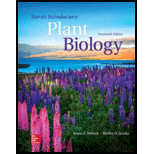
Concept explainers
To write:
The functions of meristems and its location.
Introduction:
Meristems are the undifferentiated cells present in those zones of plants where growth occurs. The main functions of meristems include giving rise to various organs and overall growth of plants. Differentiated cell0020types can only produce cells of one type but the undifferentiated cells of meristems can produce cells of different types. The cells of meristems are entirely filled with protoplasm. Moreover, the cells contain very small vacuole, undifferentiated plastids, and large nuclei. There are three types of meristematic tissue: apical, lateral and intercalary.
Explanation of Solution
Meristems are undifferentiated cells present in the plants at those locations where the growth occurs. The meristems are divided into three categories: apical meristems, intercalary meristems, and lateral meristems.
The apical meristems are present at the ends of the roots (root apical meristem) and at the ends of the shoots (shoot apical meristems). These apical meristems are responsible for the plant's growth. This growth is termed as primary growth. The presence of apical meristem promotes vertical growth and hinders the lateral development. So, if we remove the apical meristem then lateral growth gets activated.
The lateral meristems are responsible for lateral growth or growth in diameter. This growth takes place when the stem is well formed. So, this growth is termed as secondary growth. There are two types of lateral meristems: the vascular cambium and the cork cambium. The vascular cambium is responsible for the production of secondary xylem and phloem. While the cork cambium produces periderm.
The intercalary meristems are also known as the basal meristems. They are located at the internodes or the places where the leaves are attached. It is located near the apical meristem but does not helps in the growth like that of apical meristems. It promotes growth at the base of the plants. This meristem makes the leaves to grow inspite of being cut down.
Meristem is the tissue containing undifferentiated cells. The cells in this tissue are responsible for the growth and development of the organs. Based on its location it is divided into three types: apical meristem, a lateral meristem, and intercalary meristem. The apical meristems are present at the roots (root apical meristem) and at the stems (shoot apical meristem). The apical meristems are responsible for the growth of the plant and bud formation. Now, the second type is the lateral meristems. These tissues are responsible for increasing the diameter of the stems. These are responsible for secondary growth. The third type of meristem is intercalary meristem. These tissues are present at the internode or the places where the leaves are attached. This meristem is responsible for the growth of leaves even when they wore out.
Want to see more full solutions like this?
 Human Anatomy & Physiology (11th Edition)BiologyISBN:9780134580999Author:Elaine N. Marieb, Katja N. HoehnPublisher:PEARSON
Human Anatomy & Physiology (11th Edition)BiologyISBN:9780134580999Author:Elaine N. Marieb, Katja N. HoehnPublisher:PEARSON Biology 2eBiologyISBN:9781947172517Author:Matthew Douglas, Jung Choi, Mary Ann ClarkPublisher:OpenStax
Biology 2eBiologyISBN:9781947172517Author:Matthew Douglas, Jung Choi, Mary Ann ClarkPublisher:OpenStax Anatomy & PhysiologyBiologyISBN:9781259398629Author:McKinley, Michael P., O'loughlin, Valerie Dean, Bidle, Theresa StouterPublisher:Mcgraw Hill Education,
Anatomy & PhysiologyBiologyISBN:9781259398629Author:McKinley, Michael P., O'loughlin, Valerie Dean, Bidle, Theresa StouterPublisher:Mcgraw Hill Education, Molecular Biology of the Cell (Sixth Edition)BiologyISBN:9780815344322Author:Bruce Alberts, Alexander D. Johnson, Julian Lewis, David Morgan, Martin Raff, Keith Roberts, Peter WalterPublisher:W. W. Norton & Company
Molecular Biology of the Cell (Sixth Edition)BiologyISBN:9780815344322Author:Bruce Alberts, Alexander D. Johnson, Julian Lewis, David Morgan, Martin Raff, Keith Roberts, Peter WalterPublisher:W. W. Norton & Company Laboratory Manual For Human Anatomy & PhysiologyBiologyISBN:9781260159363Author:Martin, Terry R., Prentice-craver, CynthiaPublisher:McGraw-Hill Publishing Co.
Laboratory Manual For Human Anatomy & PhysiologyBiologyISBN:9781260159363Author:Martin, Terry R., Prentice-craver, CynthiaPublisher:McGraw-Hill Publishing Co. Inquiry Into Life (16th Edition)BiologyISBN:9781260231700Author:Sylvia S. Mader, Michael WindelspechtPublisher:McGraw Hill Education
Inquiry Into Life (16th Edition)BiologyISBN:9781260231700Author:Sylvia S. Mader, Michael WindelspechtPublisher:McGraw Hill Education





